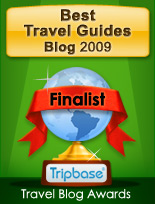 Going on that great Aussie road trip and planning on doing it all? Making the wrong choice when considering which vehicle to hire can leave you missing out on some of Australia's most spectacular scenery — or even stranded in the outback. As part of the three month road trip through four states of Australia which Terry and I recently completed while researching guidebooks, we tested out several different 4WD vehicles and in our story Campervanning for Beginners published recently on NineMSN's travel site, we explain the pros and cons of each vehicle and how to decide on the right one to suit your style of travel and type of journey. Essentially, there are two main vehicle choices for this kind of trip, a 4WD campervan and a motorhome. But while motorhomes are spacious and comfortable and allow you to stop anywhere and make a meal or take a nap, they're generally 2WD, rendering many of the country's most scenic bush tracks (especially those we wanted to tackle) off-limits to travllers. As Terry writes in the story: "Any feelings of envy for those decked-out homes-on-wheels with onboard bathrooms would soon be forgotten as we passed them turning around at the start of tracks signposted "high-clearance 4WD only". A motorhome may get you to the Blue Mountains but it's not going to take you along the Birdsville Track!" And we know where we'd rather go.
Going on that great Aussie road trip and planning on doing it all? Making the wrong choice when considering which vehicle to hire can leave you missing out on some of Australia's most spectacular scenery — or even stranded in the outback. As part of the three month road trip through four states of Australia which Terry and I recently completed while researching guidebooks, we tested out several different 4WD vehicles and in our story Campervanning for Beginners published recently on NineMSN's travel site, we explain the pros and cons of each vehicle and how to decide on the right one to suit your style of travel and type of journey. Essentially, there are two main vehicle choices for this kind of trip, a 4WD campervan and a motorhome. But while motorhomes are spacious and comfortable and allow you to stop anywhere and make a meal or take a nap, they're generally 2WD, rendering many of the country's most scenic bush tracks (especially those we wanted to tackle) off-limits to travllers. As Terry writes in the story: "Any feelings of envy for those decked-out homes-on-wheels with onboard bathrooms would soon be forgotten as we passed them turning around at the start of tracks signposted "high-clearance 4WD only". A motorhome may get you to the Blue Mountains but it's not going to take you along the Birdsville Track!" And we know where we'd rather go.
Pictured? Terry putting the vehicle into 4WD in preparation for a muddy track ahead.
Sunday, February 15, 2009
Campervanning for Beginners
Posted by
Lara Dunston
at
5:08 AM
![]()
Labels: 4WD-ing, Australia, Campervanning for beginners, campervans/kombis/RVs
Subscribe to:
Post Comments (Atom)


























2 comments:
When undertaking such a road trip how much car-knowledge is needed?
Is there a high likelihood that your car will break down once or twice and you'll need to fix it?
Changing tires, I'm all over. But beyond that --
There is a chance, which is why it's so important to get the right car for the kind of trip you want to do.
Obviously, if you hire a vehicle and it breaks down you contact the rental company and they'll organize for someone to come fix it. (Which is why if you're doing the outback tracks, you also need a satellite phone and an emergency kit.) However, because they're maintained so well, the chances of a Britz or Maui vehicle like the ones we rented breaking down are low.
However, if they do break down, and you're stuck on an outback track in the middle of nowhere, and someone has to come fix it, you might have to wait a day or so, but the thing is that they will come, something that can't be relied upon if you buy a second-hand car for your big trip as a lot of young travellers do.
A lot of travellers do get themselves in trouble - mostly because they try to do 4WD tracks in 2WD station wagons or kombis - and have to be rescued by the local station owners (farmers) or national parks rangers or, even worse, emergency services. These people have better things to do than rescue travellers who've made foolish choices or undertaken a trip unprepared, which is, I guess, why we try to publish these kinds of stories.
But if you are prepared and adventurous, these sorts of trips are far more rewarding than driving the Sydney to Brisbane route that most travellers to Australia do. For the wildlife and plant-life alone! Spectacular stuff!
Post a Comment